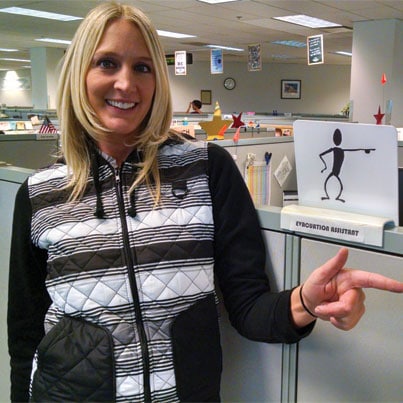by California Casualty | Safety |

Today is America’s PrepareAthon, the culmination of FEMA’s National Preparedness Month. The idea is for individuals, communities and organizations to be prepared for six specific hazards:
The message is that families, businesses and neighborhoods should know their risks, have a plan of action and prepare survival kits.
It got us thinking; “How prepared is California Casualty?”
First, client and employee safety is paramount at California Casualty. Security systems are in place at all our service centers. The company conducts drills for fires and other possible occurrences – complete with trained safety personnel who help with evacuations and account for employees when safety zones are reached. These evacuation assistants are trained in first aid, CPR and the use of automatic electronic defibrillators (AED).
California Casualty has implemented a business continuity and recovery plan should an earthquake, flood, fire, tornado, power outage or winter storm adversely affect operations at one or more of our service centers. Managers carry contact information for every employee so they can be reached in an emergency. Systems are in place so that key personnel can operate remotely and phone and data systems can be shifted to service centers that have not been impacted. This minimizes inconvenience and potential disruption to policy holders.
Yearly table-top disaster scenarios are run to make sure managers know the procedures and backup systems they can utilize. In worse case scenarios, staff can be temporarily relocated to other services centers to maintain the continuity of service to clients. With service centers in Kansas, Colorado, Arizona and California, California Casualty has the redundancies and virtual call routing to maintain operations even if a service center is completely down.
California Casualty also has an emergency outreach plan for clients who may be affected by a disaster. Calls are made to areas that have been hit by flood, fire, tornado, hurricane or flood to make sure our insureds are okay and to expedite help with claims. Our Field Managers and Claims personnel respond to disaster areas to make contact with those insured with California Casualty and aid in their safety, relocation and recovery.
California Casualty works very hard to keep client information and data protected with numerous advanced data security protocols and monitoring. As an added layer of safety, every auto and home insurance policy includes free 911 ID Theft Protection.
Preventing tragedies is also a main concern. California Casualty strives to help our policy holders prepare for various disaster scenarios with many links and preparedness tips at our website’s Resources page.
Are you prepared? Today is the day to make sure with America’s PrepareAthon.
by California Casualty | Safety |
Last night’s tragic tornadoes in Texas serve as a reminder that deadly storms can form and escalate with little warning.
The best time to prepare for a Tornado or severe storm is before it hits.
So prepare today.
Here are some helpful hints for how to prepare:
- Build an emergency kit. Tips for building the kit can be found here.
- Develop a family communication plan. Here are some suggestions.
- Be alert. Pay attention to the weather outside (until you need to take cover- then stay away from the windows!). These are danger signs:
- Dark, greenish sky
- Large hail
- Large, dark, low-lying clouds (especially if they are rotating)
- Loud roar similar to a train
- If you see any of these signs- take shelter immediately.
- Pay attention to the news. Know the guidelines of when you should take cover.
- Locate and mark where utility switches and valves are in your home so they can be turned off in an emergency if time allows
- Charge your mobile phone, laptop and other mobile device batteries
- Brush up on your watches and warning terms. That way, you’ll understand the risk and can better make safety and evacuation decisions
- Severe thunderstorm watch: Conditions are conducive to the development of severe thunderstorms in and around the watch area. These storms produce hail of ¾ inch in diameter and/or wind gusts of at least 58 mph.
- Severe thunderstorm warning: Issued when a severe thunderstorm has been observed by spotters or indicated on radar, and is occurring or imminent in the warning area. These warnings usually last for a period of 30 to 60 minutes.
- Tornado watch: Conditions are favorable for the development of severe thunderstorms and multiple tornadoes in and around the watch area. People in the affected areas are encouraged to be vigilant in preparation for severe weather.
- Tornado warning: Spotters have sighted a tornado or one has been indicated on radar, and is occurring or imminent in the warning area. When a tornado warning has been issued, people in the affected area are strongly encouraged to take cover immediately.
- Review what to do DURING a tornado. Have a plan for different locations: at home, in the car, at an outdoor event, etc. Here is a great guide.
- If you evacuate and safely have time, notify friends and/or family members who are unaffected by the storm of where you’re going and why.
- Photograph your valuables and store them in a fire and waterproof safe. Also use the safe to store important documents such as birth certificates, ownership documentation for cars and boats, Social Security cards, insurance policies and wills.
- Check your homeowner’s insurance to confirm your coverage in case your home is damaged or destroyed. Tornadoes can be accompanied by heavy rains and flooding, which most homeowner’s insurance policies do not cover. Here’s some information on California Casualty’s coverage.
For more tips check out these sources:
- Federal Emergency Management Agency (FEMA)
- The Weather Channel
- The National Oceanic and Atmospheric Administration (NOAA)
by California Casualty | Safety |
It’s officially September!
Goodbye Summer sunshine, hello Fall foliage!

Aside from being the season of cider and sweaters, Fall is also…
National Preparedness Month.
Here at CalCas, we will be celebrating by posting weekly Preparedness content right here on our Blog 🙂
First on deck: A Preparedness App!
As a recent iPhone converter, I am all aboard the App train. I’m always on the lookout for exciting new stuff and this new app from the Insurance Information Institute is one such find!
It’s called the “Know Your Plan” App and it’s all about streamlining your Disaster Prep Plans.
What you should know about this App:
What it provides:
- A library of preloaded preparedness checklists for disasters including:
- Hurricanes
- Floods
- Earthquakes
- Tornadoes
- Severe Cold
- Wildfires
- Evacuation
- Tips for preparing an emergency kit
- Important property protection information
- Step-by-step preparedness tips
- Custom lists for your personalized preparedness plan
- Targeted task completion dates
- Tools to chart your progress (including a countdown feature!)
- Checklists share options for family and friends
- Evacuation resources (even one for pets!)
- Geotargeted emergency alert feeds for up-to-the minute information about local evacuation routes and other disaster information
- User-customizable notes
As Fall and September swing into full gear, make sure you are ahead of the curve when it comes to Disaster Preparedness.
After all, you never know when you may need it.
By compiling disaster preparedness information and plans all in one place–on your phone–you are putting life-saving plans in place.
Stay tuned for more great Preparedness content throughout the month!


